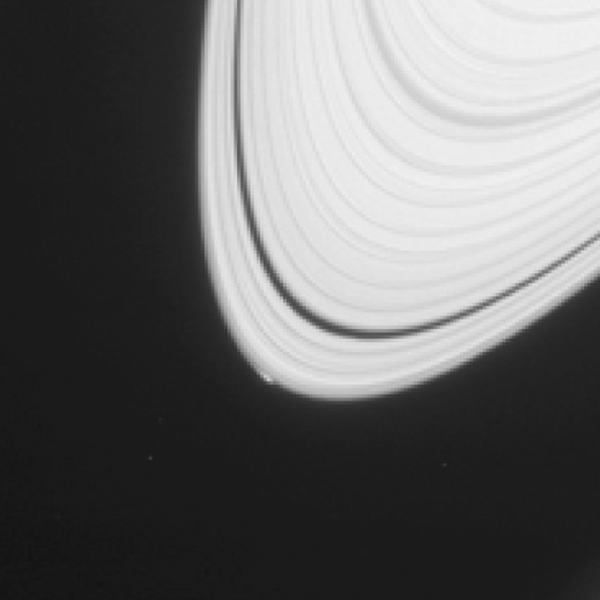Science News
A Moon is Born
April 15, 2014
by Molly Michelson

Saturn has around 62 moons, not all as famous as Titan and Enceladus. In fact, several of them don’t even have names. Many of the moons consist primarily of ice, as do the particles that form Saturn’s rings. Because of this, scientists have thought that some of the moons originated from the rings.
Now they may have evidence. Images taken with NASA’s Cassini satellite last year show disturbances at the very edge of Saturn’s A ring—the outermost of the planet’s large, bright rings. One of these disturbances is an arc about 20 percent brighter than its surroundings, 750 miles (1,200 kilometers) long and 6 miles (10 kilometers) wide. Scientists also found unusual protuberances in the usually smooth profile at the ring’s edge. The team believes the arc and protuberances are caused by the gravitational effects of a nearby object.
“We have not seen anything like this before,” says Carl Murray of Queen Mary University of London and team leader. “We may be looking at the act of birth, where this object is just leaving the rings and heading off to be a moon in its own right.”
The object, informally named Peggy, is not expected to grow any larger, and may even be falling apart. Although it’s too small to see in images so far, the researchers estimate it is probably less than a half mile in diameter. The sizes of Saturn’s icy moons vary proportionally with their proximity to the planet—in general, the farther from the planet, the larger the moon.
“Witnessing the possible birth of a tiny moon is an exciting, unexpected event," says Cassini Project Scientist Linda Spilker, of NASA’s Jet Propulsion Laboratory (JPL). She also says that Cassini’s orbit will move closer to the outer edge of the A ring in late 2016, providing an opportunity to study Peggy in more detail and perhaps even image it.
But Peggy could be the last of Saturn’s moons. Saturn’s rings now are, in all likelihood, too depleted to make more. “The theory holds that Saturn long ago had a much more massive ring system capable of giving birth to larger moons,” Murray says. “As the moons formed near the edge, they depleted the rings and evolved, so the ones that formed earliest are the largest and the farthest out.”
The study is published in the journal Icarus.
Image: NASA/JPL-Caltech/Space Science Institute